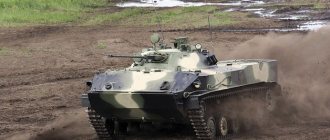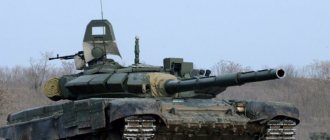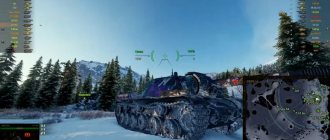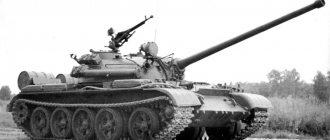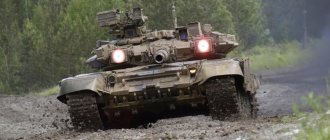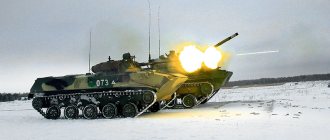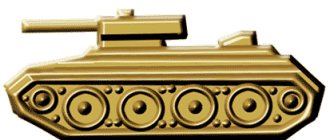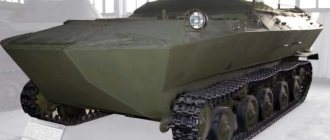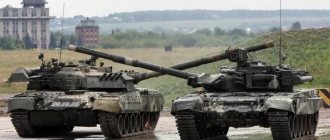Let's look at the light Soviet tank, what's good about it. Description of the main characteristics, what features the tank has, pros and cons. What experienced users say, is it worth buying this equipment or not.
USSR technology
| Light tanks | I MS-1 • II BT-2 • II T-45 • II T-26 • II T-60 • II Tetrarch • III BT-7 • III BT-SV • III LTP • III M3 light • III BT-7 artillery • III T-116 • III T-127 • III T-46 • III T-70 • IV A-20 • IV T-80 • IV Valentine II • V T-50 • VI MT-25 • VI T-50- 2 • VII LTG • VIII LTTB • VIII LT-432 • IX T-54 lightweight • X T-100 LT |
| Medium tanks | III T-29 • IV A-32 • IV T-28E with F-30 • IV T-28 • V Matilda IV • V T-34 shielded • V T-34 • VI A-43 • VI T-34-85M • VI T-34-85 Rudy • VI M4-A2 Sherman Lozy • VI T-34-85 • VII A-44 • VII KV-13 • VII T-43 • VII T-44-122 • VIII Object 416 • VIII T-54 first sample • VIII T-44-100 (B) • VIII T-44-100 (P) • VIII T-44-100 (U) • VIII STG • VIII STG Guardsman • VIII T-44 • IX Object 430 Option II • IX Object 430 • IX T-54 • X Object 140 • X Object 907 • X T-22 avg. • X K-91 • X Object 430U • X T-62A |
| Heavy tanks | V Churchill III • V KV-1S • V KV-220-2 • V KV-220-2 Beta-Test • V KV-1 • VI KV-2 • VI KV-2 (R) • VI KV-85 • VI Object 244 • VI T-150 • VII IS • VII KV-3 • VII KV-122 • VII IS-2M • VII IS - 2 • VIII IS-3 • VIII IS-6 • VIII IS-6 H • VIII KV- 5 • VIII KV-4 • VIII IS-5 (Object 730) • VIII IS-3 with MZ • VIII KV-4 Kreslavsky • VIII Object 252U Defender • VIII Object 252U • VIII IS-M • VIII Object 703 Option II • VIII IS-2-II • IX T-10 • IX Object 257 • IX Object 705 • IX IS-3-II • IX ST-I • X IS-4 • X IS-7 • X Object 260 • X Object 705A • X Object 277 • X Object 279 early • X ST-II |
| Tank destroyer | II AT-1 • III SU-76M • III SU-76I • IV SU-85B • V SU-85 • V SU-85I • VI SU-100 • VI SU-100Y • VII ISU-122S • VII SU-152 • VII SU-100M1 • VII SU-122-44 • VIII ISU-152 • VIII ISU-130 • VIII T-103 • VIII SU-130PM • VIII SU-101 • IX Object 704 • IX Object 263 • X Object 268 • X Object 268 Option 4 |
| self-propelled guns | II SU-18 • III SU-26 • IV SU-5 • V SU-122A • VI SU-8 • VII S-51 • VII SU-14-1 • VIII SU-14-2 • IX 212A • X Object 261 |
Light tanks
| USSR technology | I MS-1 • II BT-2 • II T-45 • II T-26 • II T-60 • II Tetrarch • III BT-7 • III BT-SV • III LTP • III M3 light • III BT-7 artillery • III T-116 • III T-127 • III T-46 • III T-70 • IV A-20 • IV T-80 • IV Valentine II • V T-50 • VI MT-25 • VI T-50- 2 • VII LTG • VIII LTTB • VIII LT-432 • IX T-54 lightweight • X T-100 LT |
| German technology | I Leichttraktor • II Pz.Kpfw. II Ausf. D • II MKA • II Pz.Kpfw. 38H 735 (f) • II Pz.Kpfw. 35 (t) • II Pz.Kpfw. I • II Pz.Kpfw. II • III 43 M. Toldi III • III Pz.Kpfw. 38 (t) • III Pz.Kpfw. III Ausf. E • III Pz.Kpfw. II Ausf. J • III Pz.Kpfw. I Ausf. C • III Pz.Kpfw. II Ausf. G • III Pz.Kpfw. T 15 • IV Pz.Kpfw. 38 (t) nA • IV Pz.Kpfw. II Luchs • V VK 16.02 Leopard • VI VK 28.01 • VII Aufklärungspanzer Panther • VII Spähpanzer SP IC • VIII leKpz M 41 90 mm • VIII leKpz M 41 90 mm GF • VIII HWK 12 • VIII HWK 30 • IX Spähpanzer Ru 251 • X Rheinmetall Panzerwagen |
| US technology | I T1 Cunningham • II M2 Light Tank • II T1E6 • II T2 Light Tank • II T7 Combat Car • III M22 Locust • III M3 Stuart • III MTLS-1G14 • M5 Stuart • V M24 Chaffee • V M7 • VI T21 • VI T37 • VII T71 CMCD P • VII T71 CMCD • VII T71 DA • VIII T92 • VIII M41 Walker Bulldog • IX T49 • X XM551 Sheridan |
| French technology | I Renault FT • II D1 • II AM 39 Gendron-Somua • II AMR 35 • II FCM 36 • II Renault R35 • II Hotchkiss H35 • III AMX 38 • IV AMX 40 • V AMX ELC bis • VI AMX 12 t • VI Panhard AMD 178B • VII AMX 13 75 • VII Hotchkiss EBR • VII AMX 13 57 • VII AMX 13 57 GF • VIII Panhard EBR 75 (FL 10) VIII Panhard AML Lynx 6×6 • VIII Bat.-Châtillon 12 t • VIII ELC EVEN 90 • IX AMX 13 90 • IX Panhard EBR 90 • X Panhard EBR 105 • X AMX 13 105 |
| UK technology | II Cruiser Mk. I • II M2 • II Cruiser Mk. III • II Light Mk. VIC • III Stuart I-IV • III Cruiser Mk. IV • III Cruiser Mk. II • IV Valentine • IV Covenanter • VII GSR 3301 Setter • VIII FV1066 Senlac • VIII LHMTV • IX GSOR3301 AVR FS • X Manticore |
| Chinese technology | I Renault NC-31 • II Vickers Mk. E Type B • III Type 2597 Chi-Ha • IV M5A1 Stuart • VI 59-16 • VI Type 64 • VII Type 62 • VII WZ-131 • VIII WZ-132 • VIII M41D • IX WZ-132A • X WZ-132 -1 |
| Japanese technology | I Renault Otsu • II Type 95 Ha-Go • II Type 97 Te-Ke • III Type 98 Ke-Ni • IV Type 5 Ke-Ho |
| Technology of Czechoslovakia | I Kolohousenka • II LT vz. 35 • III LT vz. 38 |
| Equipment of Poland | I 4TP • II TKS z nkm 20 mm • II 7TP • III 10TP • IV 14TP |
| Swedish technology | I Strv fm/21 • II Strv m/38 • II L-60 • III Strv m/40L |
| Italian technology | I Fiat 3000 • II L6/40 |
Technical description
The BT-5 was a “hybrid” model designed to replace the unsuccessful BT-2 design among the troops. The hull of the BT-5 is practically no different from its predecessor (except for the transition to the metric system), which was a consequence of the requirement of the UMM of the Red Army “alterations must be carried out without interfering with mass production” (modifications of the BT-4 and BT-6, which differed from the original sample design of the hull and a number of minor modifications, did not reach the stage of mass production). Therefore, the “five” differed from the “two” primarily in the new elliptical turret on a widened shoulder strap with a 45-mm 20K cannon with 115 rounds of ammunition and a machine gun; on some tanks there was a second one in the turret niche, on some there was also an anti-aircraft diesel gun on the turret. Crew - 3 people. The BT-5 was produced in versions with and without a walkie-talkie. The command tank had a walkie-talkie and reduced ammunition.
The BT-5 retained the layout of the BT-2 tank: the front location of the control compartment, the middle location of the fighting compartment and the aft location of the engine and transmission compartment. The tank's hull and turret are frame, with bulletproof armor. The cylindrical tower with a niche in the rear part was installed on a ball bearing on the roof of the building. The crew boarded through hatches located in the frontal part of the hull and the roof of the turret. Rolled armor plates, 6÷13 mm thick, were connected with rivets. The frontal sheets of the hull are inclined at relatively large angles to the vertical plane, and the front sheets of the sides are inclined to the longitudinal axis of the vehicle, which further increased their protective properties. In the front part of the fenders there were visors that protected the viewing devices from dirt and snow. Towing hooks are located in the front and rear parts of the hull.
Armament: includes a 45 mm semi-automatic cannon mounted in the turret mantlet and a coaxial 7.62 mm DT tank machine gun. The gun was designed to fire at tanks and armored vehicles, artillery, open infantry fire weapons and enemy personnel, armor-piercing and fragmentation shells, and had good tactical and technical indicators for that time. The barrel length is 46 calibers, the direct fire range is 3600 m, the longest is 4800 m. An armor-piercing projectile weighing 1.425 kg, initial speed - 760 m/s, penetrated armor 32 mm thick at a firing distance of 1000 m at an impact angle of 90º. The gun's rate of fire is 12 rounds/min, with aiming corrected. Guidance during direct fire from a cannon and a coaxial machine gun, monitoring the results of fire and its adjustment were carried out using TSMF and PT-1 tank optical sights. The design of the turret made it possible to fire all-round fire from a cannon and machine gun in a horizontal plane, with vertical guidance angles from −6 to +25º. Ammunition includes 115 artillery rounds and 2,709 rounds of ammunition (43 magazines). The command vehicle carried 72 artillery rounds. Viewing slits with glass blocks located in the frontal part of the hull and the side surfaces of the turret were used as observation devices in a combat situation.
The means of external communication were signal flags, and the command vehicles were equipped with tank transceiver telephone and telegraph simplex radio stations 71-TK-1 with a handrail antenna located on the turret. The radio station installed in the niche of the tower provided communication when operating in telephone mode at a distance of up to 15 km while moving and up to 30 km when parked, and in telegraph mode when parked - up to 50 km. Internal communication was provided by a TPU-3 tank intercom for three subscribers.
Aviation engine, brand M-5: 12-cylinder, V-shaped carburetor, liquid cooling, power 294 kW (400 hp), allowed to reach speeds of up to 50 km/h on tracks and up to 72 km/h on wheels. The engine was located longitudinally in the rear part of the hull, with the toe of the crankshaft towards the stern, and had relatively small weight and dimensions, respectively: 410 kg; 1754×691×1073 mm. Fuel - aviation gasoline.
The mechanical transmission consisted of: a multi-disc dry friction clutch (steel on steel), mounted on the toe of the engine crankshaft, a four-speed gearbox, two multi-disc side clutches with band brakes (turning mechanisms), two single-stage final drives and gearboxes (guitars) for drive to the rear road wheels, which became the driving wheels when the vehicle was moving on wheels. The guitar contains five gears that transmit torque from the drive wheel shaft of the caterpillar track to the rear road wheel. The guitar's housing served as a balancer for the rear road wheel.
The track propulsion unit (for one side) consisted of: a large-link caterpillar chain of ridge engagement with an open hinge, four road wheels with a diameter of 815 mm, a idler wheel with a mechanism for tensioning the track chain, a rear drive wheel with four drive rollers. The track rollers had external shock absorption in the form of rubber bands. Individual suspension (independent). Spiral cylindrical springs (candles) connecting the balancers of the road wheels to the body are used as elastic elements. The springs are located vertically inside the housing (horizontally for the first road wheel).
When switching from tracked to wheeled, the track chains were removed, laid on the fenders and secured with belts. Blocking rings were installed in the hubs of the rear road wheels, connecting them to the guitar's drive shaft. The standard time required to transfer a vehicle by the crew from a tracked vehicle to a wheeled one (and vice versa) did not exceed 30 minutes. To control the rotation of the tank on caterpillar tracks, the control compartment had two levers connected by means of longitudinal rods with side clutches, and on wheels - a steering wheel with a rack and pinion steering mechanism connected by rods to the front controlled road wheels. When driving on tracks, the steering wheel was removed.
Electrical equipment: made according to a one-wire circuit, on-board voltage 12 V. Battery ignition system. The spark plugs of each bank of engine cylinders received electricity from their own transformer-distributor, which was a combination of a high-voltage coil with a breaker-distributor. The engine was started by two electric starters or using a starting handle mounted on the starting gearbox in the fighting compartment.
Fire fighting equipment system: consisting of a stationary tetrachlorine fire extinguisher connected by piping to four spray nozzles installed in the engine compartment.
Crew composition: three people: commander, gunner and driver. The commander and gunner were seated in the fighting compartment on both sides of the gun, and the driver was in the control compartment. The commander additionally performed the duties of loader and radio operator.
Performance characteristics:
Purpose / Long-range group tank; Type: Light wheeled-tracked vehicle with cannon armament; Year of manufacture: 1933; Combat weight - 11.5 tons; Crew - 3 people; Maximum speed, on tracks / on wheels - 52/72 km/h; Armament: 45 mm tank gun, 7.62 mm tank machine gun, mounted in the turret; Ammunition: 115 artillery rounds (commander's - 72) and 2,709 rounds of ammunition; Reservations: bulletproof: forehead, side, rear, turret - 13 mm, roof - 10 mm, bottom -6 mm; Caterpillar type - large-link ridge gear; Number of tracks - 46; Track width - 260 mm; Track pitch - 255 mm; Number of road wheels - 4 × 2; The type of track tension mechanism is crank; The length of the supporting surface is 3000 mm; Track - 1970 mm; Ground clearance - 350 mm; Average specific pressure - 0.066 MPa (0.66 kgf/cm²); Fuel range: on the highway, on wheels 330 km / on tracks 500 km; Obstacles to be overcome: climb angle - 42°; roll angle - 35°; ditch width - 1.8 m; scarp height - 0.76 m; ford depth - 1.0 m; thickness of the tree to be felled / 0.35 m; Overall dimensions: length - 5350 mm; width - 2230 mm; height - 2200 mm;
Archival documents
Results of tests of the shielded tank BT-7, carried out during the period March 15-28, 1944
The shielded radio tank BT-7 No. 0189-2 203 Tbr was involved in the tests; the tank's caterpillar was small-linked; after the last major overhaul, the engine and all the raspberries worked for 28 hours 27 minutes. After shielding, the weight of the tank increased by 1.5 tons. The tank was tested at 100 % combat configuration and crew composition: 3 people. The route and test mode are outlined in the attached test log. During the test period, 843 km were covered (380 km on the highway, 463 km on a country road, rough terrain and obstacles), the engine worked for 33 hours and 10 m.
The tests revealed:
- On one refueling of the main tanks (without additional ones) 322 kilometers were covered.
- Due to the weight of the tank's bow, starting in 1st gear is done at 500-600 engine revolutions (previously 400 revolutions). On country roads of unsatisfactory condition (presence of a large number of potholes, bumps, etc.), there is a large swing of the bow of the tank in the vertical plane, which makes it difficult to control the tank and limits the speed of movement; movement is possible in 1st and 2nd gears in medium operating mode, with speed » 8-12 km/hour.
- With a two-hour continuous movement and 120 km. march for 5 running hours with two stops (for inspection), the thermal conditions of the engine and heating of the transmission units and chassis are normal.
- Gasoline consumption without exceeding a driving speed of 30 km. /hour and engine speed 1650 rpm. /min. with a specific gravity of KB-70 gasoline of 0.765, an average of 33.8 kg. for 1 hour at an outside air temperature of 10°. Lubrication of tank units and mechanisms, established by the lubrication table for the BT-7 tank, according to the mode and amount of lubricant, ensures normal operation of the tank units.
Surviving copies
Several copies of the BT-5 tank have survived to this day. The tank is on display at the Museum of Armored Vehicles in Kubinka.
Also, BT-5, raised from the bottom of the Neva and restored in 2007, can be seen in the city of Kirovsk (Leningrad region)[1]. Another BT-5 (Mariupol turret with a small rear niche) was installed as a monument in the city of Borzya; the BT-5 tank has now been transferred to the museum of the city of Chita.
There is one tank in Rostov-on-Don, the tank has been restored literally to a screw and I wear it “Khmarovets” in honor of Khmara Stanislav Sergeevich cs323727.vk.me/v323727064/9421/NSM7HD0AhVo.jpg
In addition, 5 copies of the BT-5 tank were installed as monuments in Mongolia - on Mount Bain-Tsagan, in the cities of Under-Khan, Sumber, etc.[2]
- BT tank in the Breakthrough of the Siege of Leningrad Museum 4.jpg
BT-5 near the diorama “Breaking the Siege of Leningrad.” Left-back view.
Service and combat use
BT-7 tanks were supplied primarily to tank brigades of mechanized corps, as well as to individual mechanized (since 1939 tank) brigades and were intended to develop a breakthrough into the depths of enemy defenses (in accordance with the theory of deep offensive operations).
Fighting near Lake Khasan
The BT-7 received its baptism of fire in the battles near Lake Khasan in August 1938 in the 2nd Mechanized Brigade (MBB), whose reconnaissance battalion included BT-7 tanks that participated in the defeat of the Japanese at the Zaozernaya Hill. Upon arrival in the combat area, the 2nd Mechanized Brigade, which was part of the 39th Rifle Corps, was tasked with supporting the attack of the 40th and 32nd Infantry Divisions. The T-26 tanks bore the brunt of the fighting at Lake Khasan. Of the 19 BT-7s that took part in the battles, 5 were shot down and 1 burned out.
Battles at Khalkhin Gol
Then he massively participated in the battles on Khalkhin Gol as part of the 6th and 11th tank brigades, the latter marched from Borzya station to the border of the Mongolian People's Republic and further through Bain-Tumen and Tamtsak-Bulak to the western bank of the river in 55 running hours. Khalkhin Gol, having covered about 800 km on caterpillar tracks in just 6 days (the average daily march of the brigade's tank battalions was up to 150 km). Soviet troops concentrated near the river. Khalkhin Gol, were consolidated into the 1st Army Group under the command of Corps Corps G.K. Zhukov. The group's troops in mid-August 1939 had 493 tanks, 346 armored vehicles, 532 guns and mortars, and 515 aircraft. The main losses of Soviet tank units were from enemy artillery fire and, in particular, from 37-mm anti-tank guns and 70-mm battalion howitzers mod. 1932. However, during the battles, all damaged and damaged tanks were evacuated by line tanks to collection points for emergency vehicles of tank battalions, where they were repaired, mainly in an aggregate manner. To evacuate damaged vehicles, each company was assigned two tanks, which, moving behind their battle formations, fought, and when a convenient moment presented itself, they evacuated the damaged vehicles. During the battles, shortcomings were also revealed in the training of both personnel and in the management of units and units in battle. The command and enlisted personnel did not know the periscope sight well enough and practically did not use it. In addition, the gunners had little knowledge of the structure of the tank gun and could not quickly correct minor weapon malfunctions. Major shortcomings were made in the organization of interaction between tanks and infantry. There was often no time allocated for organizing interaction between units and formations, and tankers often had to figure out the tasks already during the battle. 48 BT-7 were irretrievably lost in the battles at Khalkhin Gol (including one BT-7 artillery).
Assessing the actions of Soviet tank crews in the battles at Khalkhin Gol, G. K. Zhukov in May 1940, at a reception with I. V. Stalin on the occasion of his appointment to the post of commander of the Kiev Special Military District and conferring the military rank of army general, emphasized: “Very The tank brigades fought well, especially the 11th, led by brigade commander Hero of the Soviet Union M.P. Yakovlev. But the BT-5 and BT-7 tanks are too flammable. If I had not had two tank and three motorized armored brigades at my disposal, we certainly would not have been able to encircle and defeat the Japanese 6th Army so quickly.” In general, the tanks received good reviews, but they noted the difficulty of control, which required a high level of training for driver mechanics, insufficient armor protection and unsatisfactory equipment with communications equipment. Marshal G.K. Zhukov later noted their shortcomings due to the inconvenience of using these tanks on sandy ground on wheels.
All these shortcomings were confirmed in the Polish campaign in September 1939 and in the war with Finland. The BT-7 tanks participating in it were mainly concentrated in the 10th Tank Tank (1st and 13th Light Brigades, 15th St. Petersburg Brigade), 34th Light Brigade and the reconnaissance battalion of the 20th Tank Brigade. On the other hand, the tank was not had no equal in maneuverability. The tank became the pride and deserved symbol of the armored forces of the Red Army in the pre-war years, since it most closely corresponded to the idea of tanks as the main striking force of the ground forces.
But, nevertheless, in the conflict near Lake Khasan, one BT-7 was irretrievably lost, another 48 were destroyed in battles near the Khalkhin Gol River (including one BT-7 artillery), 7 vehicles became victims of the Liberation Campaign in Poland and 123 - Soviet-Finnish war.
In popular culture
Bench modeling
The BT-5 light tank is not widely represented in bench modeling. The only prefabricated plastic model of mediocre quality in 1:35 scale is produced by Zvezda (Russia). Models of several modifications of the BT-5 tank on a scale of 1:72 are produced by the Ukrainian company UM; they also produce a model on a scale of 1:100 as a gaming unit for the board game “The Great Patriotic War”.
The BT-5 tank model can be purchased together with the 24th issue of the Russian Tanks magazine. Assembled paper model of the BT-5 tank, scale 1:35. . Movable elements: tower, cannon. The model is assembled without the use of scissors and glue. Also, a plastic model in this scale is produced by
Star
.
Experimental modifications
- BT-IS-7 - with six-wheel drive (project only).
- BT-SV-2 “Turtle” - with a new shape of the armored hull and turret.
- KBT-7 - command tank with a fixed wheelhouse instead of a turret
- HBT-7 is a chemical tank designed for flame throwing, contamination of the area with toxic substances, degassing and setting up a smoke screen.
- OT-7 (OP-7) - flamethrower tank. Converted from BT-7M.
- TT-BT-7 and TUBT-7 are radio-controlled tanks (teletanks).
- In March 1935 - January 1937, 2 bridges were tested on the BT-7 tank. The first bridge weighs 1050 kg (together with accessories and fastenings) and is 7 m long. The second bridge is 7.5 m long.
- BT-7 shielded with additional armor sheets. A prototype was built and took part in the 1941 parade.
Various devices were also tested to increase cross-country ability - swamp tracks, wooden fascines, etc.
Links
Small tanks T-33 ·
T-34
·
T-41
· T-37A ·
Shitikov Tank
· T-38 ·
T-43
· T-38М ·
T-39
·
T-43-2
·
T-51
·
T-116
·
TM Tank
·
0 -10Escort tanks "Renault-Russian" · "Motor ship AN" ·
T-16
· T-18 ·
T-19
·
D-10
·
D-11
·
TMM
· T-26 ·
T-126 (SP)
·
T-26-5 (Project 126-1)
·
Project 126-2
·
Project 127
·
KT-26
·
T-26A
·
T-46
·
T-26M
·
STZ-25
·
STZ-35
·
T-111
·
Object 211Maneuverable tanks T-12 · T-24 · ·
TA-1/TA-2
·
D-4
·
D-5
· BT-2 ·
BT-203
·
PT-1/PT-1A
·
IT-3
·
D-38
·
BT flying tank
·
BT-5 · BT-6
·
RBT-5
·
BT Tsyganova
· BT-7 · BT-7A ·
BT-5-IS
·
BT-SV-2
·
Hovercraft
·
MAS-1
·
A-20
·
A- 32Breakthrough tanks GUVP*/GUVP** ·
TG-VI
·
T-30
·
TP-1
·
TG-5
·
T-42
·
TA-3
· T-35 ·
Sirken Tank
·
Danchenko Tank
· T-28 ·
T-39
·
T-29
·
Design Bureau breakthrough tanks LKZ
·
Object 112
·
SMK
·
T-100
·
Object 115
·
Object 0-50
·
Object 103
· ·
T-100-Z
·Chemical tanks XT-26 OT-27/XT-27 MHT-1 · OT-37/HT-37 · HT-130 · HT-133 ·
BKhM-2/ХБТ-7
·
OT-131/OT-132
·
HT-134
·
Object 218
·
OT-7
·
D-15
·
OU- T-26Engineering tanks ST-26/UST-26 ·
SBT-5
·
DMT-28
·
SBT-2
·
ST-27
·
IT-28
·
ST-26СО
·
T-26TSLight self-propelled guns "Arsenalets" · T-27M ·
SU-1
·
SU-2
·
"Putilovets"
·
SU-3
·
SU-76
·
SU-6
· SU-5 · AT-1 · SU-26 ·
SU-37
·
SU-45Medium and heavy self-propelled guns 152-mm coastal self-propelled gun Tolochkova ·
SU-7
·
SU-8
·
SU-14/SU-14-1
·
SU-100-Y
·
Object 212Light armored vehicles dietary supplement-1 · D-8/D-12 · FAI ·
Grokhovsky's combat motorcycle
·
GAZ-TK
· BA-20 · BA-30 ·
BA-21
·
LB-23
·
LB-NATI
·
FAI-2Medium armored vehicles BA-27 · D-9 · D-13 ·
FVV
· BA-I · BA-3 ·
BA-6S
· BA-6 ·
BA-9
· BA-10 ·
LB-62Heavy armored vehicles BA-5 BA-11
Floating armored vehicles dietary supplement-2 ·
PB-4
·
Armored hovercraft
·
PB-7Chemical armored vehicles D-18/37 ·
BHM-1000/800
· KS-18 ·
BA-23Self-propelled guns on a car chassis SU-12/SU-1-12 · SU-4 · 29K · Armored personnel carriers D-14 ·
TR-1
·
TR-4
·
Shitikov armored personnel carrier
·
BA-22Armored tractors AT-42 · "Pioneer" · T-20 "Komsomolets" · T-26T
Armored snowmobile Grokhovsky's combat snowmobile Motorized armored carriages D-1 · D-2 · KZ-1 ("Red Star-1") · MBV Armored railcars D-37 · BTC · DTR · · BD-39 · BD-41 · Leningrad armored handcar
Italic experimental samples and those that did not go into mass production were identified
T-50
The first copies of the T-50 appeared shortly before World War II. However, soon the Soviet industry decided to abandon the production of this model and make a more advanced machine based on it. This is how the legendary T-34 appeared. It was the famous “thirty-four” that subsequently had a huge influence on the development of tank building in many countries of the world.
Excerpt characterizing BT-5
“You, calm Moscow residents, artisans and working people, whom misfortunes have removed from the city, and you, absent-minded farmers, whom unfounded fear still detains in the fields, listen! Silence returns to this capital, and order is restored in it. Your fellow countrymen come out boldly from their shelters, seeing that they are respected. Any violence committed against them and their property is immediately punished. His Majesty the Emperor and King protects them and among you does not consider anyone to be his enemies, except those who disobey his commands. He wants to end your misfortunes and return you to your courts and your families. Comply with his charitable intentions and come to us without any danger. Residents! Return with confidence to your homes: you will soon find ways to satisfy your needs! Craftsmen and hardworking craftsmen! Come back to your handicrafts: houses, shops, security guards are waiting for you, and for your work you will receive the payment due to you! And you, peasants, finally come out of the forests where you hid in horror, return without fear to your huts, in the exact assurance that you will find protection. Storehouses have been established in the city, where peasants can bring their excess supplies and land plants. The government took the following measures to ensure free sale for them: 1) Starting from this date, peasants, farmers and those living in the vicinity of Moscow can, without any danger, bring their supplies to the city, of whatever kind, in two designated storage areas, that is, at Mokhovaya and Okhotny Ryad. 2) These foodstuffs will be purchased from them at such a price as the buyer and seller agree upon; but if the seller does not receive the fair price he demands, then he will be free to take them back to his village, which no one can prevent him from doing under any circumstances. 3) Every Sunday and Wednesday are designated weekly for major trading days; why a sufficient number of troops will be stationed on Tuesdays and Saturdays on all major roads, at such a distance from the city, to protect those carts. 4) The same measures will be taken so that there are no obstacles on the way back to the peasants with their carts and horses. 5) The funds will be immediately used to restore normal trading. Residents of the city and villages, and you, workers and artisans, no matter what nation you are! You are called upon to fulfill the paternal intentions of His Majesty the Emperor and the King and to contribute with him to the general welfare. Bring respect and trust to his feet and do not hesitate to unite with us!” In order to raise the morale of the troops and the people, reviews were constantly held and awards were given out. The emperor rode horseback through the streets and consoled the residents; and, despite all his preoccupation with state affairs, he himself visited the theaters established on his orders. In terms of charity, the best valor of the crowned people, Napoleon also did everything that depended on him. On charitable institutions he ordered the inscription Maison de ma mere [My Mother's House], uniting by this act the tender filial feeling with the greatness of the virtue of the monarch. He visited the Orphanage and, letting the orphans he saved kiss his white hands, graciously talked with Tutolmin. Then, according to Thiers’ eloquent account, he ordered that the salaries of his troops be distributed in Russian, made by him, with counterfeit money. Relevant l'emploi de ces moyens par un acte digue de lui et de l'armee Francaise, il fit distribuer des secours aux incendies. Mais les vivres etant trop precieux pour etre donnes a des etrangers la plupart ennemis, Napoleon aima mieux leur fournir de l'argent afin qu'ils se fournissent au dehors, et il leur fit distribuer des roubles papiers. [Elevating the use of these measures to an action worthy of him and the French army, he ordered the distribution of benefits to the burnt. But, since food supplies were too expensive to give to people of a foreign land and for the most part hostile, Napoleon considered it best to give them money so that they could obtain food for themselves on the side; and he ordered that they be provided with paper rubles.] With regard to the discipline of the army, orders were constantly issued for strict penalties for failure to fulfill the duty of service and for the cessation of robbery. X But it’s a strange thing, all these orders, concerns and plans, which were no worse than others issued in similar cases, did not affect the essence of the matter, but, like the hands of a dial in a watch, separated from the mechanism, spun arbitrarily and aimlessly, without affecting the wheels . Militarily, the ingenious campaign plan that Thiers talks about; que son genie n'avait jamais rien imagine de plus profond, de plus habile et de plus admirable [his genius never invented anything deeper, more skillful and more amazing] and regarding which Thiers, entering into polemics with Mr. Fehn, proves that the drawing up of this brilliant plan should be dated not to the 4th, but to the 15th of October, this plan never was and could not be executed, because it had nothing close to reality. The strengthening of the Kremlin, for which it was necessary to tear down la Mosquee [mosque] (as Napoleon called St. Basil's Church), turned out to be completely useless. Laying mines under the Kremlin only contributed to the fulfillment of the emperor’s desire, upon leaving Moscow, for the Kremlin to be blown up, that is, for the floor on which the child was killed to be beaten. The persecution of the Russian army, which so concerned Napoleon, presented an unheard-of phenomenon. The French military leaders lost the sixty-thousandth Russian army, and only, according to Thiers, the art and, it seems, also the genius of Murat managed to find, like a pin, this sixty-thousandth Russian army. Diplomatically, all of Napoleon’s arguments about his generosity and justice, both before Tutolmin and before Yakovlev, who was primarily concerned with acquiring an overcoat and a cart, turned out to be useless: Alexander did not accept these ambassadors and did not respond to their embassy. From a legal point of view, after the execution of the alleged arsonists, the other half of Moscow burned down. Administratively, the establishment of the municipality did not stop the robbery and only brought benefit to some individuals who participated in this municipality and, under the pretext of maintaining order, robbed Moscow or saved theirs from robbery. In terms of religion, things that were so easily arranged in Egypt by visiting a mosque did not bring any results here. Two or three priests found in Moscow tried to carry out the will of Napoleon, but one of them was beaten on the cheeks by a French soldier during the service, and the French official reported the following about the other: “Le pretre, que j'avais decouvert et invite a recommencer a dire la messe, a nettoye et ferme l'eglise. Cette nuit on est venu de nouveau enfoncer les portes, casser les cadenas, dechirer les livres et commettre d'autres desordres.” [“The priest, whom I found and invited to begin saying mass, cleaned out and locked the church. That same night they came again to break doors and locks, tear up books and cause other disturbances.”] In terms of trade, there was no response to the proclamation to the hardworking artisans and all peasants. There were no hardworking artisans, and the peasants caught those commissars who went too far with this proclamation and killed them. With regard to entertaining the people and troops with theatres, things were similarly unsuccessful. The theaters established in the Kremlin and in Poznyakov’s house immediately closed because actresses and actors were robbed. Charity did not bring the desired results either. False banknotes and fake ones filled Moscow and had no price. For the French, who collected booty, all they needed was gold. Not only were the false banknotes that Napoleon so graciously distributed to the unfortunate had no price, but silver was given below its value for gold. But the most striking phenomenon of the invalidity of the highest orders at that time was Napoleon's efforts to stop the robberies and restore discipline. This is what the army officials reported. “Robberies continue in the city, despite orders to stop them. Order has not yet been restored, and there is not a single merchant conducting trade in a legal manner. Only sutlers allow themselves to sell, and only looted things.” “La partie de mon arrondissement continue a etre en proie au pillage des soldats du 3 corps, qui, non contents d'arracher aux malheureux refugies dans des souterrains le peu qui leur reste, ont meme la ferocite de les blesser a coups de sabre, comme j'en ai vu plusieurs exemples." “Rien de nouveau outre que les soldats se permettent de voler et de piller. Le 9 October.” “Le vol et le pillage continuent.” Il ya une bande de voleurs dans notre district qu'il faudra faire arreter par de fortes gardes. Le 11 October.” [“Part of my district continues to be plundered by the soldiers of the 3rd Corps, who are not content with taking away the meager property of the unfortunate inhabitants who hid in the basements, but also cruelly inflict wounds on them with sabers, as I myself have seen many times.” “Nothing new, just that soldiers allow themselves to rob and steal. October 9." “Theft and robbery continue. There is a gang of thieves in our area that will need to be stopped with strong measures. October 11.”] “The Emperor is extremely dissatisfied that, despite strict orders to stop the robbery, only detachments of Guards marauders are visible returning to the Kremlin. In the old guard, riots and looting resumed more than ever yesterday, last night and today. The emperor sees with condolences that the selected soldiers appointed to guard his person, who should set an example of subordination, are disobedient to such an extent that they destroy the cellars and stores prepared for the army. Others humiliated themselves to the point of not listening to the sentries and guard officers, cursing them and beating them.” “Le grand marechal du palais se plaint vivement,” wrote the governor, “que malgre les defenses reiterees, les soldats continuent a faire leurs besoins dans toutes les cours et meme jusque sous les fenetres de l’Empereur.” [“The chief master of ceremonies of the palace complains strongly that, despite all the prohibitions, the soldiers continue to walk for an hour in all the courtyards and even under the windows of the emperor.”] The army is like a loose herd, trampling underfoot the food that could save him from starvation, disintegrated and perished with every day of extra stay in Moscow. But it didn't move. It ran only when it was suddenly seized by panic caused by the interceptions of convoys along the Smolensk road and the Tarutino battle. This same news about the Battle of Tarutino, which Napoleon unexpectedly received at the review, aroused in him a desire to punish the Russians, as Thiers says, and he gave the order to march, which the entire army demanded. Fleeing from Moscow, the people of this army took with them everything that was looted. Napoleon also took with him his own tresor [treasure]. Seeing the convoy cluttering the army. Napoleon was horrified (as Thiers says). But he, with his war experience, did not order to burn all the extra carts, as he did with the marshal’s carts, approaching Moscow, but he looked at these carriages and carriages in which the soldiers were riding, and said that it was very good that These crews will be used for provisions, sick and wounded. The position of the entire army was like that of a wounded animal, feeling its death and not knowing what it was doing. Studying the skillful maneuvers of Napoleon and his army and his goals from the time of his entry into Moscow until the destruction of this army is like studying the meaning of the dying leaps and convulsions of a mortally wounded animal. Very often, a wounded animal, hearing a rustle, rushes to shoot at the hunter, runs forward, backward and itself speeds up its end. Napoleon did the same under pressure from his entire army. The rustle of the Tarutino battle scared the beast, and he rushed forward to the shot, ran to the hunter, came back, forward again, back again, and finally, like any animal, he ran back, along the most unfavorable, dangerous path, but along a familiar, old trail. Napoleon, who seems to us to be the leader of this entire movement (how wild the figure carved on the bow of the ship seemed to be, with the power guiding the ship), Napoleon during all this time of his activity was like a child who, holding on to the ribbons tied inside the carriage, imagines that he ed. On October 6, early in the morning, Pierre left the booth and, returning back, stopped at the door, playing with a long purple dog on short crooked legs that was spinning around him. This little dog lived in their booth, spending the night with Karataev, but sometimes she went somewhere in the city and returned again. It had probably never belonged to anyone, and now it was owned and had no name. The French called her Azor, the soldier storyteller called her Femgalka, Karataev and others called her Gray, sometimes Visly. The fact that she didn’t belong to anyone and that she didn’t have a name or even a breed, or even a specific color, didn’t seem to make things difficult for the purple little dog. Her furry tail stood firmly and roundly up, her crooked legs served her so well that often she, as if neglecting the use of all four legs, gracefully raised one hind leg and very deftly and quickly ran on three legs. Everything was a matter of pleasure for her. Now, squealing with joy, she lay on her back, now she was basking in the sun with a thoughtful and significant look, now she was frolicking, playing with a sliver of wood or a straw. Pierre's attire now consisted of a dirty, torn shirt, the only remnant of his previous dress, soldier's trousers, tied with strings at the ankles for warmth on Karataev's advice, a caftan and a peasant's hat. Pierre changed a lot physically during this time. He no longer seemed fat, although he still had the same appearance of size and strength that was hereditary to their breed. A beard and mustache have grown over the lower part of the face; the overgrown, tangled hair on his head, filled with lice, now curled up like a cap. The expression in the eyes was firm, calm and animatedly ready, such as Pierre’s gaze had never had before. His former licentiousness, which was also expressed in his gaze, was now replaced by an energetic, ready for activity and rebuff - selectedness. His feet were bare. Pierre looked either down across the field, through which carts and horsemen were driving around this morning, then into the distance across the river, then at the little dog pretending that it seriously wanted to bite him, then at his bare feet, which he gladly rearranged into different positions, wiggling his dirty, thick, thumbs. And every time he looked at his bare feet, a smile of animation and self-satisfaction crossed his face. The sight of these bare feet reminded him of everything that he had experienced and understood during this time, and this memory was pleasant to him. The weather had been calm and clear for several days, with light frosts in the mornings - the so-called Indian summer. It was warm in the air, in the sun, and this warmth, with the invigorating freshness of the morning frost still felt in the air, was especially pleasant. Everything, both distant and nearby objects, had that magical crystal shine that only happens at this time of autumn. In the distance one could see the Sparrow Hills, with a village, a church and a large white house. And bare trees, and sand, and stones, and roofs of houses, and the green spire of a church, and the corners of a distant white house - all this was unnaturally clearly cut out in the thinnest lines in the transparent air. Nearby could be seen the familiar ruins of a half-burnt manor house, occupied by the French, with dark green lilac bushes growing along the fence. And even this ruined and dirty house, repulsive with its ugliness in cloudy weather, now, in its bright, motionless brilliance, seemed somehow soothingly beautiful.
TTX
Let's take a closer look at the vehicle's parameters and compare it with other Soviet premium LTs, which many players received for free as gifts for Tankman's Day, DR WoT or New Year.
Firepower
It has at its disposal a 45 mm cannon with a single damage of 47 units, and armor penetration with a basic armor-piercing projectile is 51 mm, that is, like all other light vehicles. The gold sub-caliber with 84 mm penetration is also no different.
Ammunition characteristics:
The ammunition capacity is quite large - 80 rounds.
In terms of rate of fire, it is slightly inferior to its counterparts, but surpasses everyone in the aiming speed of 1.64 seconds. and accuracy 0.39. The average damage per minute is one of the minimum, but due to the parameters of the gun it has a greater chance of realizing its fire potential. The main obstacle will be vertical guidance angles -4...+22°.
Vitality
The safety factor is slightly above average 240 units. Nominal armor values are not highlighted, but it's not that simple. Hull armor feature in its form.
Booking scheme
The fact is that the armor plates are located at a large angle, about 80 mm in scale, so it can often catch ricochets, especially at high speed. The sides have additional protection in the form of screens.
Module location
Location of modules:
Other indicators
One of the heaviest LTs with a mass of 13.11 tons, but due to a good engine it has a very high specific power, which makes it the fastest with a top speed of 62 km/h. But the rate of rotation of the chassis is not encouraging; there will be problems with turns during acceleration. For the presence of armor and its dimensions it pays with a low stealth coefficient. Observation indicators are depressing 280/313 meters.
Development of new towers
In addition, the second stage of tanks produced at Plant No. 183 was marked by the replacement of the entire tank armament and the installation of radio stations on all tanks. Thus, the linear tank was re-equipped with a 45-mm cannon, as a result of which it could serve as a maneuverable tank in armored cavalry brigades. The main difference between the new linear tank and the T-23B1 was the new turret with a 20K cannon. According to the original project, developed at Plant No. 183 in the summer of 1932, to install a new turret, it was supposed to lengthen the tank hull (compared to the T-23B1) by 225 mm in the cross section of the fighting compartment so that the distances between the three pairs of rear rollers remained unchanged. Increasing the distance between the first and second rollers was supposed to improve handling on wheels. Otherwise the vehicle remained similar to the T-23B1. However, it was necessary to lengthen the tank body precisely between the second and third rollers, since the load on the front pair of rollers sharply increased, which led to rapid wear of the tires. The hull was lengthened by 115 mm and a larger turret was installed. The tower had a small aft niche to accommodate a radio station. However, it was difficult to call the new tower, produced by the Mariupol plant, successful. In addition, the production of turrets was always late, and only in 1934, thanks to the involvement of the Izhora plant in this work and the actual unification of the turret installation with the T-26, it was possible to bridge the gap between the production of hulls and turrets. The tower from the Izhora plant was accepted for production at the Mariupol plant - therefore all the towers were identical.
Wheeled-tracked tank T-23B2

